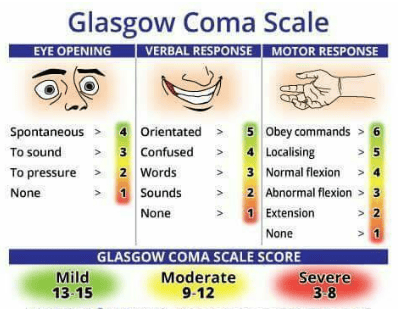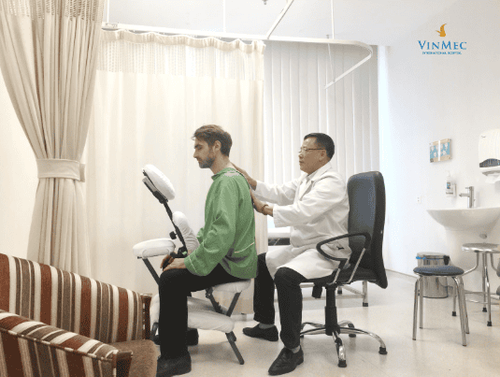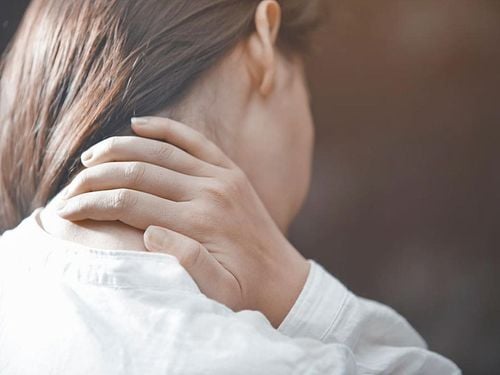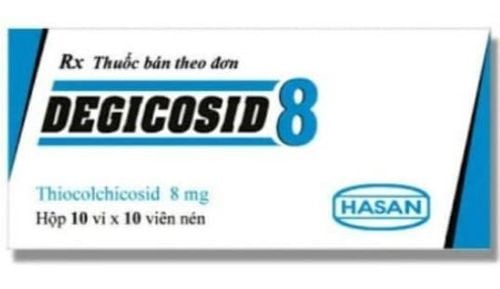This is an automatically translated article.
Neck pain is a common symptom of primary care clinic patients. Approximately 10% to 15% of the world's population suffers from neck pain at any time, and 40% of the population will experience neck pain within a 12-month period. Causes of pain vary from strain/sprain. to cervical myelopathy. There is still no consensus on how to treat neck pain comprehensively. The article will help you better understand the 5 points on the neck and effective pain relief solutions.
1. What is neck pain?
Our neck is made up of vertebrae that extend from the skull to the upper body. Cervical discs have the ability to absorb shocks between bones. The bones, ligaments, and muscles in the neck support our head and allow movement. Any abnormality, infection, or injury can cause pain or stiffness in the neck, shoulders, or back.
Many people experience pain or stiffness from time to time. In most cases, it's because the area is poorly positioned or overactive. Sometimes, neck pain is caused by injuries from falls while playing sports or hitting the neck, shoulders, or back. In most cases, neck pain is not a serious condition and can be relieved within a few days.
But in some cases, neck pain can be a sign of a serious injury or health problem and requires a doctor's care. If you have neck pain that lasts more than a week, is severe, or is accompanied by other symptoms, seek medical attention immediately.
1.1. Causes of neck pain
Neck pain or stiffness can happen for many reasons:
Muscle tension Muscle tension is often the result of behaviors such as:
Improper posture Working at a desk for too long without changing position Lying in the wrong position Sleep Position Overexertion during neck exercises Neck Injuries: Neck is particularly susceptible to injury, especially in situations such as: falls, car accidents and playing sports, where the muscles and ligaments in the neck are forced to move outside their normal range. If the bones of the neck (cervical vertebrae) are broken, the spinal cord can also be damaged. Neck trauma caused by a sudden jerk of the head is considered a dangerous form of trauma. Heart attack : Neck pain can also be a symptom of a heart attack and it often comes along with other symptoms, such as: Shortness of breath Sweating Nausea Vomiting Arm pain or jaw pain If your neck If you have pain accompanied by other heart attack symptoms, call an ambulance or go to the emergency room right away.
Meningitis : Meningitis is an inflammation of the thin tissue that surrounds the brain and spinal cord. In people with meningitis, accompanying symptoms are often fever and headache in addition to a stiff neck. Meningitis can be fatal and is considered a medical emergency. If symptoms of meningitis appear, seek help immediately.
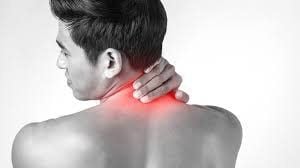
Căng cơ là một trong những nguyên nhân dẫn đến đau cổ
1.2. Some other reasons
Other causes that can lead to pain or stiffness in the neck, shoulders, and back include:
Rheumatoid arthritis causes pain, swelling in the joints and bone spurs. When these occur in the neck area, we can experience neck pain. Osteoporosis is weakening of bones and can lead to small fractures. This condition will usually occur in the hands or knees, but it can also occur in the neck. Fibromyalgia is a condition that causes muscle pain throughout the body, especially in the neck and shoulder area. As we age, the cervical discs can degenerate. This is called spondylolisthesis, or cervical spondylosis. This can narrow the space between your vertebrae. It also puts extra pressure on our joints. When a disc protrudes, due to an injury, it can put extra pressure on the spinal cord or nerve roots. Here, called cervical disc herniation aka ruptured or slipped disc. Spinal stenosis occurs when the spine narrows and puts pressure on the spinal cord or nerve roots as it exits the vertebrae. This may be due to prolonged inflammation from arthritis or other medical conditions. In rare cases, neck stiffness or pain occurs due to:
Congenital abnormalities Infections Abscesses Neck tumors Spine cancer
2. 5 points on the neck: Comprehensive neck pain treatment
Muscle strain and back strain are common causes of neck, shoulder, and back pain. Worn joints and broken cartilage can also be a factor in this condition. Neck pain is usually concentrated in one spot in the neck, but it can also be diffuse. This type of pain will likely be in the form of stiffness or spasms. Over the years, some people have turned to acupressure for neck pain relief. Acupressure identifies points on the body that can be massaged and stimulated to relieve painful symptoms associated with a certain health problem. Acupressure treatment for neck pain is still being evaluated for clinical effectiveness, but scientific evidence suggests it works for some people.
Acupuncture has been studied extensively as a treatment for neck pain. Although there is some evidence that acupuncture works for neck pain, acupressure is not widely accepted as a treatment for neck pain. Researchers wondered, for example, whether acupuncture needles stimulated chemicals in the body that help relieve pain. If this is the case, stimulating pressure points with massage instead of needles will not provide the same relief of pain. But that doesn't mean acupressure should be ruled out as a comprehensive neck pain treatment. Stimulating pressure points can relieve neck pain and soothe sore muscles. According to a review of several meta-study involving a wide range of scientific literature, the answer is that we still don't know the exact benefits of reflexology for neck pain.
Pressure points for neck pain
To try acupressure for neck pain, follow these steps:
Relax and take deep breaths. Be sure to choose a comfortable and quiet space to practice acupressure for neck pain. Apply strong and deep pressure to massage the points we have identified to treat neck pain. It's best to rotate your fingers in a circular motion or an up and down motion for three to four minutes at each point, focusing on each point. If you feel a sharp increase in pain anywhere on your body during treatment, stop immediately. Repeat this reflexology therapy throughout the day if it feels effective. There is no limit to the number of times per day we can practice reflexology. Below is a list of acupoints associated with several different types of neck pain. Remember that in reflexology, your whole body will be connected to each other. That means it's not uncommon for us to stimulate one part of the body to treat pain in another far away part of the body.
Jian Jing (GB21) : The Jian Jing point is located in our shoulder muscles, about halfway between our neck and shoulders. The Jian Jing point has been used in acupuncture studies with success in the treatment of headaches and muscle tension. Jian Jing can also successfully treat a sore or stiff neck. Note that stimulation of this acupoint can induce labor, so Jian Jing acupressure should not be applied to pregnant mothers. He Gu (L14): The Hegu point is located on the fold of skin between our thumb and index finger. Reflexologists claim that stimulating this acupoint can relieve pain in many different parts of the body, including the neck area. Just like the Jian Jing point, the Hegu point is also not recommended for pregnant women Fengchi (GB20): The Fengchi point is located behind our earlobes, towards the top of the neck and the base of the skull. Reflexologists use this point to treat everything from fatigue to headaches. Stimulating this pressure point can improve neck stiffness caused by sleeping in an uncomfortable position. Zhong Zu (TE3) : The Zhong Zu point is located between the knuckles above our pinky and ring fingers. The Zhong Zu point can stimulate different parts of the brain when it is activated, promoting circulation and releasing stress. Stimulating this point can relieve neck pain caused by tension. Heaven's Pillar: A spot found on either side of our neck, at the base of our skull, and about 3cm from the top of our spine. (located directly above your shoulder.) Stimulating this point can release congestion and swollen lymph nodes that can cause neck pain. Neck pain is a common condition that is often caused by poor posture or muscle tension. In these cases, our neck pain will go away if we practice correct posture and give the neck muscles rest when it hurts. Besides, there are also home remedies for neck pain based on 5 pressure points or acupressure points. However, if your neck pain does not improve with home treatments, you should see your doctor for diagnosis and treatment.
Please dial HOTLINE for more information or register for an appointment HERE. Download MyVinmec app to make appointments faster and to manage your bookings easily.
Reference source: healthline.com




